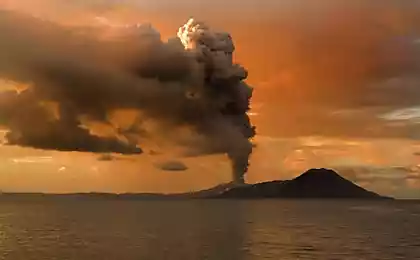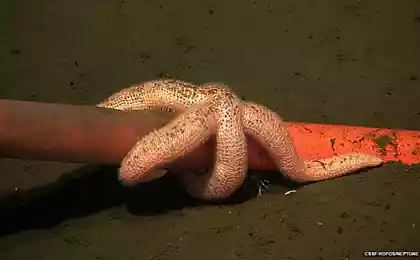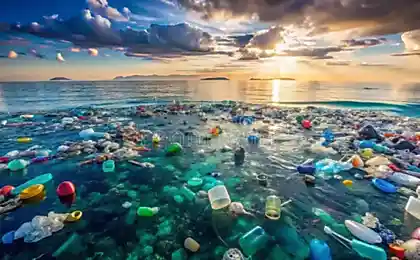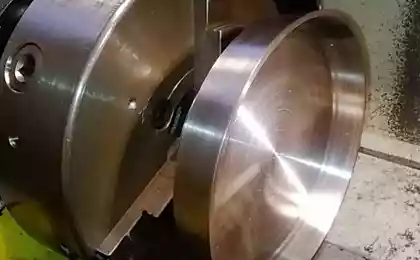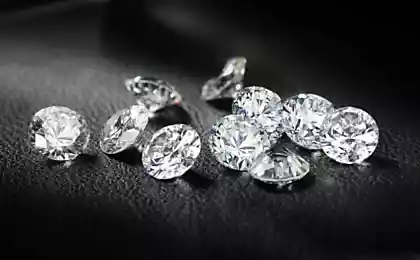600
Our bright technological future lies at the bottom of the ocean
In March 1968 a Soviet submarine Golf II ballistic nuclear missiles, exploded and sank in one and a half thousand nautical miles to the Northwest of the Hawaiian Islands. Five months later, the US government has discovered the wreckage and decided to steal them. This began project AZORIAN, one of the most absurd and ambitious operations that the CIA ever conspired.
Potential benefits of project AZORIAN, if successful, was enormous — a detailed look at the capabilities of Soviet weapons, and possibly access to some very desirable cryptographic equipment. But the 1750-ton submarine sank to a depth of five thousand meters, and it took a massive ship that would be able to get her out. Therefore, the CIA hired Howard Hughes to invent a legend to explain the construction of a 200-meter vessel.
According to legend, Hughes needed to extract manganese nodules — these stones the size of potatoes, which are naturally formed in the abyssal plains (deep ocean plains depressions and troughs of the marginal seas) is using his holding company, Summa Corporation. The billionaire industrialist builds an incredible new ship to find the treasure on the seabed. Sounds plausible — and the public believe.
"Then people did not understand that it was all a big ploy, says oceanographer Frank Sanson of the University of Hawaii at Manoa. — Just imagine: to cover the true purpose, the CIA has created a whole line of research for manganese nodules".There were years and decades, and private companies began to find that manganese nodules contain large amounts of rare earth metals of base elements that work in our smartphones, computers, defense systems and technologies of clean energy. Our needs for these elements is unlimited, but land-based sources is very limited. And now, after forty years after the conspiracy, which was invented by the CIA, we are on the verge of underwater gold rush. One day, if possible, we will get access to huge reserves of rare earth elements on the ocean floor.
"The seabed can provide all the necessary rare earth elements, says John Wiltshire, Director of the Hawaii undersea research laboratory. — All the technology needed for this, are in some form of development".But as much as we want to, the seabed for mining of rare earth metals will be very difficult. As project AZORIAN, it will be fraught with technical difficulties and enormous risks.
The term "rare earth" is a bit incorrect. Seventeen chemically similar elements, including 15 lanthanides, scandium and yttrium — are quite common in the earth's crust. More cerium than lead, and even the least common rare earth elements hundreds of times more gold.
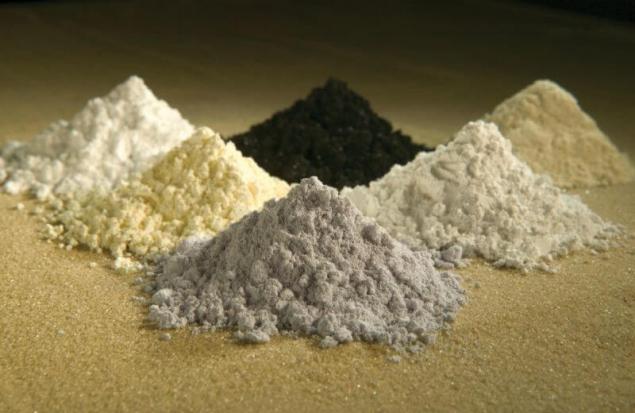
Clockwise from the black bunch: praseodymium, cerium, lanthanum, neodymium, samarium and gadolinium
But because of their geochemical properties, rare earth elements are not prone to the formation of metal-rich ores that make mining economically viable. Some minerals like bastnasite can contain up to several percent of oxides of rare earth metals. Most rare earth elements are scattered at very small concentrations. To get them, huge amounts of crushed rocks, and then subjected to physical separation, effects of corrosive acids and heat. It is an expensive, time-consuming process and it produces an unfair amount of radioactive waste.
We extract rare earth elements not because they are easy, but because they need us. "The technology sector is completely dependent on these elements, says Alex king, Director of the Institute of important materials. — Their role is unique."
There are countless ways that these metals make our technology faster, easier, safer and more efficient. Take, for example, europium, used as a red phosphor in cathode ray tubes and LCD displays. Kilograms of europium is $ 2,000 and there is no alternative. Or erbium, which acts as a laser amplifier in the optical fibre. $ 1,000 per kilogram — and no alternative substitute. Yttrium is sprinkled with thermal coating jet engines of aircraft to protect other metals from the intense heat. Neodymium is a workhorse in high-performance magnets, which are available in almost every hard disk, sound dynamics, wind turbine generator, wireless power tools and electric motors.
The list is long. Drugs for the treatment of cancer. An MRI machine. Control rods of a nuclear reactor. Lenses cameras. Superconductors. Rare earth elements are essential for such a long list of technologies that the deficit, according to the Council for natural resources, "will have a significant negative impact on the quality of our lives."
This reality worries the governments of major countries, including the United States. They are totally dependent on import of rare earth metals. And most of this import comes from China.
For many decades the American company Molycorp produces much of the rare earths in the world at a mine in mountain Pass, California. But by the middle of 1980-ies in inner Mongolia and in southern China was discovered huge deposits of these metals. Due to cheap labor and virtually without any environmental regulation, Chinese mining companies were able to outdo American industry in the 1990s — early 2000-ies. In 2002, Molycorp stopped mining. By 2010 China controlled 97% of the market.
And then China began to Flex its muscles. First introduced quotas on exports of rare earth elements, limiting the support of the world. In September 2010 the dispute over the Maritime border has prompted the Chinese government to suspend all exports of rare earth metals to Japan. These events had an impact on the international market. The price of "rare earth" took off, as technology companies began to hammer the stocks to protect yourself against possible future supply disruptions. Economist Paul Krugman, condemned by American politicians for what they have allowed China to get "monopoly, which even in my wildest dreams never dreamed the oil tyrants of the Middle East".
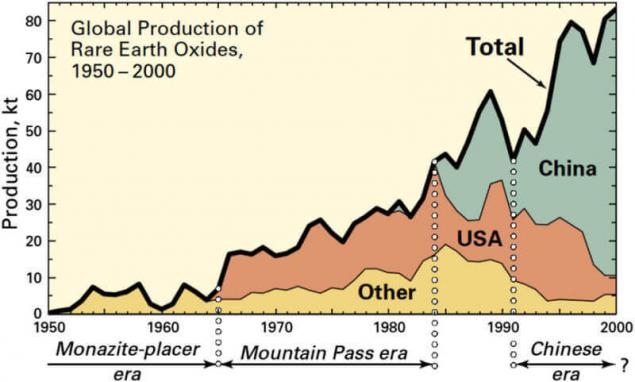
World production of rare earths from 1950 to 2000: China in the lead
Six years later, concerns about power over "rare earths" in China proved unfounded. Fear has prompted other countries to increase its own production of rare earth metals and loosen the grip of China. At the end of 2014, the world trade organization ruled against China because of improper trading practices, forcing the government to cancel quotas for rare earth elements. Prices have fallen sharply.
However, the fear of future shortages of rare earth elements have had a lasting effect on U.S. policy, prompting the Department of energy to pour millions into research on reducing the use of "rare earths" and restore them from existing products. Some industries have abandoned them — Tesla does not use rare earths in their batteries, or motors — but in some industries it is not yet possible. The demand for these metals will only grow.
"In the economy, where the use of rare earth elements is growing, you can't just swerve out of the way," says king. "In the end, you will have to open a new mine".In the gloomy dungeons of the us intelligence community was dominated by the tense atmosphere. It was summer 1974, and after six years of preparation, the operation to rescue the submarine approached climax. Hughes Glomar Explorer, a 36000-ton ship, designed for lifting an entire submarine, was unique in its kind. A special door was opened below the waterline in the middle of the ocean. Three pull-out system of piles, include the claw grip, had to drop to the seabed to capture the Soviet ship.

Hughes Glomar Explorer
The operation was a disappointment. When the submarine raised to the surface, it broke into two parts. Two-thirds of the debris, including nuclear missiles and the naval code book sink back to the seabed. In addition to the six naval officers of the USSR, it is unclear what else could get Hughes Glomar Explorer. As told Gizmodo Wiltshire, "there are at least three versions of as the unfolding of this story. We will never know exactly how much of what they get".
The CIA planned a second mission to rescue the submarine. But before she got the approval (if received), reporter Jack Anderson, who was on the trail of project AZORIAN, tore the veil from the story on national television. Soon the story appeared on the front pages of the Los Angeles Times, Washington Post and The New York Times.
The subsequent recovery mission was cancelled, but Ocean Minerals Company, a consortium led by Lockheed Martin, which developed the technology of mining to restore the submarine spent the next several years, driving Hughes Glomar Explorer around the area of Clara-Clipperton — square 3.5 million square miles in the Eastern Pacific ocean and conducting experiments for deep-sea resource extraction.
"Mining equipment for ocean, built the CIA actually worked, says Wiltshire. — Ocean Minerals Company decided to extract manganese nodules and worked with the ship until the early 1980's". These expeditions attracted the attention to the riches on the ocean floor, a number of other government agencies and private companies began to sponsor their own efforts to develop deep ocean.
Manganese concretion
Since 1960-ies of the mining companies attracted manganese nodules for the most part because of the Nickel, copper and cobalt. But over time, the geologists learned that these rocks also contain rare earth oxides, including expensive and very rare. "All large terrestrial deposits in the world are almost exclusively light rare earth elements, says Jim Hine, a specialist in oceanic minerals in the Geological service of the USA. — In sediments on the ocean floor, the percentage of heavy rare earth elements above. This is the main difference".
At first glance, the concentration of rare earth elements in manganese nodules is about 0.1% — may seem too low to pay off commercially. But according to Mike Johnston, CEO Nautilus Minerals is engaged in the development of ocean mineral resources, rare earth elements can be extracted along with other valuable ores.
"These rocks are, in fact, are the manganese with a sponge soaked in a bunch of other metals, told Johnston. — To extract other metals, it is necessary to break ties, chemically or by exposure to high temperatures. After that, it is theoretically possible to extract each metal, including rare earth".To date, the global rare earth industry produces just over 100,000 tonnes of metal per year. Only in one area of the Clarion-Clipperton estimated is 15 million tons of rare earth oxides trapped in manganese nodules.
The question, of course, not that at the bottom of the ocean there are these elements. The question is, can they get to such business made sense.
Forty years have passed since then, as project AZORIAN was the beginning of deep-sea mining industry. We not only discovered a potential condition in manganese nodules, but also many other tempting resources, including sulfide Deposit formed by underwater volcanoes and deep-sea ferromanganese crusts, which also contain rare earth elements.
But so far, no company has started to develop the seabed for commercial purposes.
Open ocean — this is not the Wild West. Since the first departure of Hughes Glomar Explorer, the UN adopted the Convention on the sea to regulate the industry in the open sea. As a result the group called the international seabed authority (ISA) is responsible for the delineation of zones of deep mining in the sea and results miserly permission in international waters.
To date, more than a dozen companies were licensed to a study of manganese nodule deposits in the Clarion-Clipperton, but none has yet received permission to actual production. First, the ISA should develop a policy to develop marine subsurface is not turned into a show on the throwing of feces, which starts when people get their hands on a new piece of raw Land.
Many environmentalists are downright terrified at the prospect of how to profit hungry corporations will begin to scrape, dig and cut down the fragile ecosystem of the seabed in search of precious metals. "We are talking about a 100% violation of environmental conditions in the target area, says Wiltshire. And because these deposits are thin, the area will be great."
We think of deep ocean water as a cold wasteland, but manganese nodules and other metal-rich subsoil are teeming with fish and marine invertebrates. These animals are usually geographically restricted and does not like violations of the conditions of their stay. Marine biologist Craig Smith in 2013 noted that organisms living in the area of the Clarion-Clipperton need thousands or millions of years to recover from the effects of mining.
Concerns raised by Smith and others, led the ISA to cut a large strip from this area is about 550,000 square miles — for long-term conservation. But protected, too, may feel the effects of mining. Raised sediment, nutrients and even toxic metals in the process of extraction can reduce the water quality impact on pelagic fish and marine mammals.
In addition to environmental issues, potential miners will be another problem: a huge financial risk.
Despite the fact that the technology for seabed mining, develop — Nautilus Minerals plans to produce the first sulfide deposits on the seabed in 2018 — our ability to collect manganese nodules remains limited. We don't have a mining system that is able to haul thousands of tons of rock to the surface from a depth of 3000 meters. No one has yet answered the question: how to get this stuff?
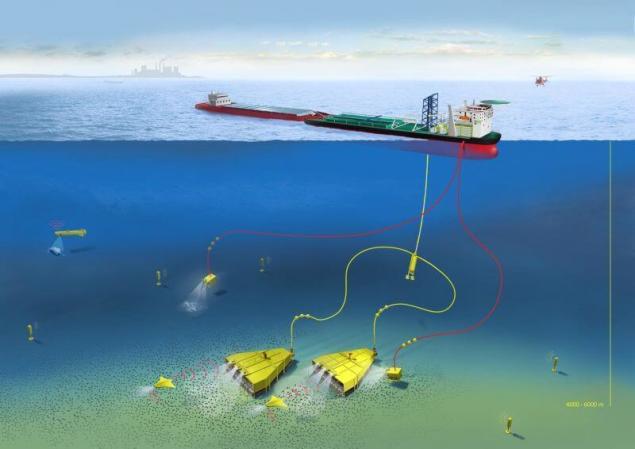
Any company that decides to take this step, will have to spend money on R&D and research areas of the bottom in which nodules are most concentrated. This is how to mine minerals on asteroids. Experts believe that deep-sea mining in the ocean is inevitable.
Forty years ago the US government has invested hundreds of millions in a bold initiative to raise part of military equipment from the ocean floor. Dare private companies on the same step to gain access to valuable rare earth metals. The stakes are not as high as in the days when two superpowers were on the brink of nuclear war. But in the future can grow. On the planet of over 7 billion people who increasingly want to have access to technology. As society moves from fossil fuels to cleaner energy sources and more silent vehicles, the demand for "rare earth" and other exotic metals will only grow. published
P. S. And remember, only by changing their consumption — together we change the world! ©
Join us in Facebook , Vkontakte, Odnoklassniki
Source: hi-news.ru/technology/nashe-svetloe-texnologicheskoe-budushhee-lezhit-na-dne-okeana.html
Potential benefits of project AZORIAN, if successful, was enormous — a detailed look at the capabilities of Soviet weapons, and possibly access to some very desirable cryptographic equipment. But the 1750-ton submarine sank to a depth of five thousand meters, and it took a massive ship that would be able to get her out. Therefore, the CIA hired Howard Hughes to invent a legend to explain the construction of a 200-meter vessel.
According to legend, Hughes needed to extract manganese nodules — these stones the size of potatoes, which are naturally formed in the abyssal plains (deep ocean plains depressions and troughs of the marginal seas) is using his holding company, Summa Corporation. The billionaire industrialist builds an incredible new ship to find the treasure on the seabed. Sounds plausible — and the public believe.
"Then people did not understand that it was all a big ploy, says oceanographer Frank Sanson of the University of Hawaii at Manoa. — Just imagine: to cover the true purpose, the CIA has created a whole line of research for manganese nodules".There were years and decades, and private companies began to find that manganese nodules contain large amounts of rare earth metals of base elements that work in our smartphones, computers, defense systems and technologies of clean energy. Our needs for these elements is unlimited, but land-based sources is very limited. And now, after forty years after the conspiracy, which was invented by the CIA, we are on the verge of underwater gold rush. One day, if possible, we will get access to huge reserves of rare earth elements on the ocean floor.
"The seabed can provide all the necessary rare earth elements, says John Wiltshire, Director of the Hawaii undersea research laboratory. — All the technology needed for this, are in some form of development".But as much as we want to, the seabed for mining of rare earth metals will be very difficult. As project AZORIAN, it will be fraught with technical difficulties and enormous risks.
The term "rare earth" is a bit incorrect. Seventeen chemically similar elements, including 15 lanthanides, scandium and yttrium — are quite common in the earth's crust. More cerium than lead, and even the least common rare earth elements hundreds of times more gold.

Clockwise from the black bunch: praseodymium, cerium, lanthanum, neodymium, samarium and gadolinium
But because of their geochemical properties, rare earth elements are not prone to the formation of metal-rich ores that make mining economically viable. Some minerals like bastnasite can contain up to several percent of oxides of rare earth metals. Most rare earth elements are scattered at very small concentrations. To get them, huge amounts of crushed rocks, and then subjected to physical separation, effects of corrosive acids and heat. It is an expensive, time-consuming process and it produces an unfair amount of radioactive waste.
We extract rare earth elements not because they are easy, but because they need us. "The technology sector is completely dependent on these elements, says Alex king, Director of the Institute of important materials. — Their role is unique."
There are countless ways that these metals make our technology faster, easier, safer and more efficient. Take, for example, europium, used as a red phosphor in cathode ray tubes and LCD displays. Kilograms of europium is $ 2,000 and there is no alternative. Or erbium, which acts as a laser amplifier in the optical fibre. $ 1,000 per kilogram — and no alternative substitute. Yttrium is sprinkled with thermal coating jet engines of aircraft to protect other metals from the intense heat. Neodymium is a workhorse in high-performance magnets, which are available in almost every hard disk, sound dynamics, wind turbine generator, wireless power tools and electric motors.
The list is long. Drugs for the treatment of cancer. An MRI machine. Control rods of a nuclear reactor. Lenses cameras. Superconductors. Rare earth elements are essential for such a long list of technologies that the deficit, according to the Council for natural resources, "will have a significant negative impact on the quality of our lives."
This reality worries the governments of major countries, including the United States. They are totally dependent on import of rare earth metals. And most of this import comes from China.
For many decades the American company Molycorp produces much of the rare earths in the world at a mine in mountain Pass, California. But by the middle of 1980-ies in inner Mongolia and in southern China was discovered huge deposits of these metals. Due to cheap labor and virtually without any environmental regulation, Chinese mining companies were able to outdo American industry in the 1990s — early 2000-ies. In 2002, Molycorp stopped mining. By 2010 China controlled 97% of the market.
And then China began to Flex its muscles. First introduced quotas on exports of rare earth elements, limiting the support of the world. In September 2010 the dispute over the Maritime border has prompted the Chinese government to suspend all exports of rare earth metals to Japan. These events had an impact on the international market. The price of "rare earth" took off, as technology companies began to hammer the stocks to protect yourself against possible future supply disruptions. Economist Paul Krugman, condemned by American politicians for what they have allowed China to get "monopoly, which even in my wildest dreams never dreamed the oil tyrants of the Middle East".

World production of rare earths from 1950 to 2000: China in the lead
Six years later, concerns about power over "rare earths" in China proved unfounded. Fear has prompted other countries to increase its own production of rare earth metals and loosen the grip of China. At the end of 2014, the world trade organization ruled against China because of improper trading practices, forcing the government to cancel quotas for rare earth elements. Prices have fallen sharply.
However, the fear of future shortages of rare earth elements have had a lasting effect on U.S. policy, prompting the Department of energy to pour millions into research on reducing the use of "rare earths" and restore them from existing products. Some industries have abandoned them — Tesla does not use rare earths in their batteries, or motors — but in some industries it is not yet possible. The demand for these metals will only grow.
"In the economy, where the use of rare earth elements is growing, you can't just swerve out of the way," says king. "In the end, you will have to open a new mine".In the gloomy dungeons of the us intelligence community was dominated by the tense atmosphere. It was summer 1974, and after six years of preparation, the operation to rescue the submarine approached climax. Hughes Glomar Explorer, a 36000-ton ship, designed for lifting an entire submarine, was unique in its kind. A special door was opened below the waterline in the middle of the ocean. Three pull-out system of piles, include the claw grip, had to drop to the seabed to capture the Soviet ship.

Hughes Glomar Explorer
The operation was a disappointment. When the submarine raised to the surface, it broke into two parts. Two-thirds of the debris, including nuclear missiles and the naval code book sink back to the seabed. In addition to the six naval officers of the USSR, it is unclear what else could get Hughes Glomar Explorer. As told Gizmodo Wiltshire, "there are at least three versions of as the unfolding of this story. We will never know exactly how much of what they get".
The CIA planned a second mission to rescue the submarine. But before she got the approval (if received), reporter Jack Anderson, who was on the trail of project AZORIAN, tore the veil from the story on national television. Soon the story appeared on the front pages of the Los Angeles Times, Washington Post and The New York Times.
The subsequent recovery mission was cancelled, but Ocean Minerals Company, a consortium led by Lockheed Martin, which developed the technology of mining to restore the submarine spent the next several years, driving Hughes Glomar Explorer around the area of Clara-Clipperton — square 3.5 million square miles in the Eastern Pacific ocean and conducting experiments for deep-sea resource extraction.
"Mining equipment for ocean, built the CIA actually worked, says Wiltshire. — Ocean Minerals Company decided to extract manganese nodules and worked with the ship until the early 1980's". These expeditions attracted the attention to the riches on the ocean floor, a number of other government agencies and private companies began to sponsor their own efforts to develop deep ocean.

Manganese concretion
Since 1960-ies of the mining companies attracted manganese nodules for the most part because of the Nickel, copper and cobalt. But over time, the geologists learned that these rocks also contain rare earth oxides, including expensive and very rare. "All large terrestrial deposits in the world are almost exclusively light rare earth elements, says Jim Hine, a specialist in oceanic minerals in the Geological service of the USA. — In sediments on the ocean floor, the percentage of heavy rare earth elements above. This is the main difference".
At first glance, the concentration of rare earth elements in manganese nodules is about 0.1% — may seem too low to pay off commercially. But according to Mike Johnston, CEO Nautilus Minerals is engaged in the development of ocean mineral resources, rare earth elements can be extracted along with other valuable ores.
"These rocks are, in fact, are the manganese with a sponge soaked in a bunch of other metals, told Johnston. — To extract other metals, it is necessary to break ties, chemically or by exposure to high temperatures. After that, it is theoretically possible to extract each metal, including rare earth".To date, the global rare earth industry produces just over 100,000 tonnes of metal per year. Only in one area of the Clarion-Clipperton estimated is 15 million tons of rare earth oxides trapped in manganese nodules.
The question, of course, not that at the bottom of the ocean there are these elements. The question is, can they get to such business made sense.
Forty years have passed since then, as project AZORIAN was the beginning of deep-sea mining industry. We not only discovered a potential condition in manganese nodules, but also many other tempting resources, including sulfide Deposit formed by underwater volcanoes and deep-sea ferromanganese crusts, which also contain rare earth elements.
But so far, no company has started to develop the seabed for commercial purposes.
Open ocean — this is not the Wild West. Since the first departure of Hughes Glomar Explorer, the UN adopted the Convention on the sea to regulate the industry in the open sea. As a result the group called the international seabed authority (ISA) is responsible for the delineation of zones of deep mining in the sea and results miserly permission in international waters.
To date, more than a dozen companies were licensed to a study of manganese nodule deposits in the Clarion-Clipperton, but none has yet received permission to actual production. First, the ISA should develop a policy to develop marine subsurface is not turned into a show on the throwing of feces, which starts when people get their hands on a new piece of raw Land.
Many environmentalists are downright terrified at the prospect of how to profit hungry corporations will begin to scrape, dig and cut down the fragile ecosystem of the seabed in search of precious metals. "We are talking about a 100% violation of environmental conditions in the target area, says Wiltshire. And because these deposits are thin, the area will be great."
We think of deep ocean water as a cold wasteland, but manganese nodules and other metal-rich subsoil are teeming with fish and marine invertebrates. These animals are usually geographically restricted and does not like violations of the conditions of their stay. Marine biologist Craig Smith in 2013 noted that organisms living in the area of the Clarion-Clipperton need thousands or millions of years to recover from the effects of mining.
Concerns raised by Smith and others, led the ISA to cut a large strip from this area is about 550,000 square miles — for long-term conservation. But protected, too, may feel the effects of mining. Raised sediment, nutrients and even toxic metals in the process of extraction can reduce the water quality impact on pelagic fish and marine mammals.
In addition to environmental issues, potential miners will be another problem: a huge financial risk.
Despite the fact that the technology for seabed mining, develop — Nautilus Minerals plans to produce the first sulfide deposits on the seabed in 2018 — our ability to collect manganese nodules remains limited. We don't have a mining system that is able to haul thousands of tons of rock to the surface from a depth of 3000 meters. No one has yet answered the question: how to get this stuff?

Any company that decides to take this step, will have to spend money on R&D and research areas of the bottom in which nodules are most concentrated. This is how to mine minerals on asteroids. Experts believe that deep-sea mining in the ocean is inevitable.
Forty years ago the US government has invested hundreds of millions in a bold initiative to raise part of military equipment from the ocean floor. Dare private companies on the same step to gain access to valuable rare earth metals. The stakes are not as high as in the days when two superpowers were on the brink of nuclear war. But in the future can grow. On the planet of over 7 billion people who increasingly want to have access to technology. As society moves from fossil fuels to cleaner energy sources and more silent vehicles, the demand for "rare earth" and other exotic metals will only grow. published
P. S. And remember, only by changing their consumption — together we change the world! ©
Join us in Facebook , Vkontakte, Odnoklassniki
Source: hi-news.ru/technology/nashe-svetloe-texnologicheskoe-budushhee-lezhit-na-dne-okeana.html




